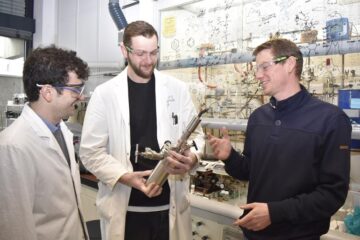Testing Fumigant Films that Keep the Air Clean

Research leader Sharon Papiernik, with the Agricultural Research Service (ARS) North Central Agricultural Research Laboratory in Brookings, S.D., used specially designed chambers to test the permeability of dozens of films used to cover fumigated soil. ARS is USDA's chief intramural scientific research agency, and the research supports the USDA commitment to agricultural sustainability.
Papiernik and her colleagues sandwiched each film between two chambers, injected fumigants into one chamber and measured both the fumigant that passed through the film into the second (receiving) chamber and the fumigant that remained in the source chamber.
The researchers tested 200 film-chemical combinations and came up with a “resistance factor” that could be used to determine emission rates for each film and fumigant under a wide range of growing conditions and weather patterns. Because each fumigant had a different chemistry, each behaved differently with each tarp.
The results, reported in the Journal of Environmental Quality, showed that some films were significantly better barriers to fumigant diffusion than others, but their effectiveness varied, depending on the fumigant tested. Some were less effective under higher humidity levels.
The work is part of a special areawide project to find the best alternatives to methyl bromide, which is being phased out as a fumigant because of its harmful effects on the Earth's protective ozone layer. The work also is intended to help the U.S. Environmental Protection Agency (EPA) and other regulators charged with developing new fumigant requirements to better protect those who use them and neighbors of treated fields.
The EPA is adapting the approach as the standard testing method for evaluating agricultural plastics used in soil fumigation. The results, along with those from other studies, have provided basic standards for film manufacturers and guidance for growers on which films offer the best options for reducing fumigant emissions.
Read more about this research in the July 2011 edition of Agricultural Research magazine.
Media Contact
More Information:
http://www.ars.usda.govAll latest news from the category: Agricultural and Forestry Science
Newest articles

Lower dose of mpox vaccine is safe
… and generates six-week antibody response equivalent to standard regimen. Study highlights need for defined markers of mpox immunity to inform public health use. A dose-sparing intradermal mpox vaccination regimen…

Efficient, sustainable and cost-effective hybrid energy storage system for modern power grids
EU project HyFlow: Over three years of research, the consortium of the EU project HyFlow has successfully developed a highly efficient, sustainable, and cost-effective hybrid energy storage system (HESS) that…

Safer alternative for an explosive reaction
The chemical industry has been using a reaction with explosive chemicals for over 100 years – now Mülheim scientists have discovered a safer alternative. The Ritter Group of the Max…





















